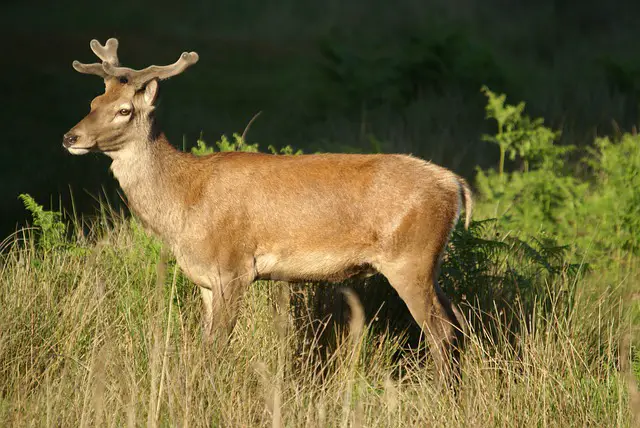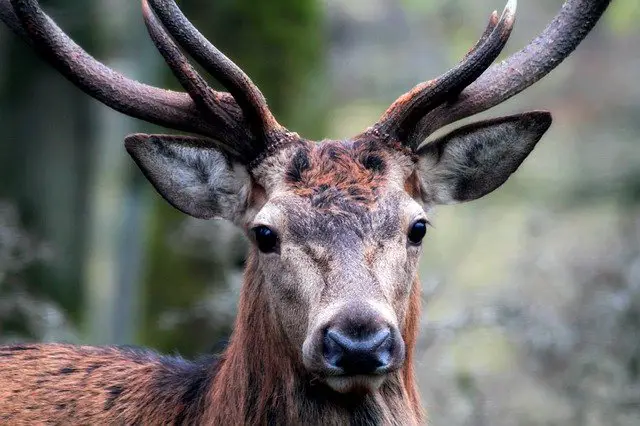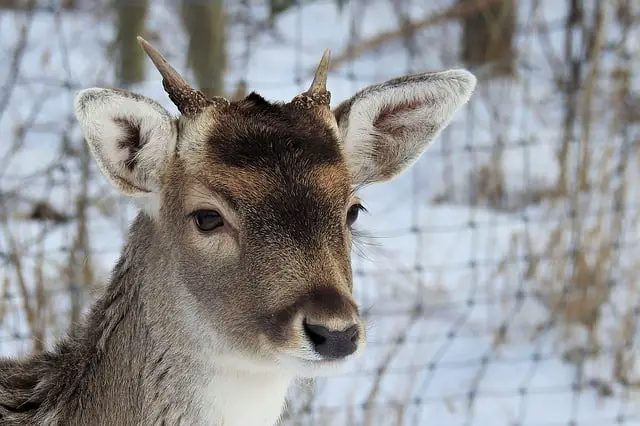Have you ever asked yourself “Why do deer shed their antlers and regrow them?” In this article we’ll explore the evolutionary and physiological reasons why deer shed their antlers, and explain the process from beginning to end.
In Short: Why Do Deer Shed Their Antlers?
Deer shed their antlers when their testosterone falls after mating, also known as their rut. This hormone decrease causes a weakening of the pedicle, which is the tissue and bone at the base of the antler.
The process of the pedicle weakening and the antlers falling off can occur quite rapidly. Even if a deer’s antlers are secure on the head on one day, they may end up falling off within 1 – 2 days.

In general, a young and very healthy buck will keep his antlers longer than an older or weaker one.
How Long Does it Take a Deer to Shed Antlers?
The entire process of shedding usually happens over 2 and 3 weeks. The process causing antlers to be regenerated occurs over the whole summer, and the entire cycle happens each year.
When do Most Deer Shed Their Antlers?
Bucks will lose their antlers as early as January to as late as April. The exact timing depends on the age of the animal, as well as the latitude of its habitat at the point after the rut has concluded.
The Antler Growth Phase
While the antlers are growing each year, they have a covering of “velvet,” a soft membrane that is a layer of skin. It provides the required nutrients to the developing antlers as they develop bone mass.

The velvet is rich in many different substances, including proteins, minerals, amino acids, and Growth-Factor 1. Growth-Factor 1 is a protein hormone with a molecular structure similar to insulin.
The growth phase for antlers takes about 2 to 4 months for most species of deer. Antler growth becomes slower during the summer when testosterone levels are higher.
During this time, the arteries and veins found around the velvet become smaller, impeding the supply of blood and nutrients.
The deer will eventually rub the antlers against trees in order to make the velvet fall off in a process called velvet shedding.
What are Antlers Made Of?
Antlers are comprised of tissue that has a bone-like texture, somewhat similar to honeycomb.
The pedicles are found at the points of the deer’s head from which the antlers grow. When the antlers are shed, they fall from the pedicles.

A male deer’s pedicles develop during the first year of its life. During the second year, small shafts will develop. It is in the third year of life that the first branch may be seen. Older deer often have thicker and longer antlers than younger ones.
In the summertime, male deer have higher amounts of testosterone. This slows down the antler’s growth, as it constricts the arteries and veins surrounding the velvet.
Around early September the velvet dries up and falls off. This leaves the bucks with hard antlers to use for ritualized contests during the mating season.
Antlers are greatly damaged during the course of the mating season by the stressors of fighting, as well as other sources of wear and tear.
Points of the antlers may even break off entirely or become blunted by the end of that time of year.
Why Do Deer Have Antlers?
The primary reason why male deer have antlers is to make them more attractive to female deer during the mating season.
During this time, the antlers are in their full growth phase. Male deer will display this to the female, and they will use their antlers to establish themselves as dominant males.
The antlers are used during fights between male deer to gain dominance and mating access to the female deer.
Deer also use their antlers when defending themselves against predators, as well as other deer. When two male deer are in a confrontation, they use their antlers to strike one another.
Sometimes the antlers will lock with one another. In extremely unfortunate circumstances, the antlers will end up so strongly locked that the deer cannot disentangle themselves and will die from starvation.
Some female deer do have antlers, but this is only the case with Reindeer who need their antlers to dig for food in the snow.
Why do Deer Have Antlers Instead of Horns?
Why do deer shed their antlers every season rather than growing horns? Part of the reason for this is the fact that deer use their antlers for specific reasons during the breeding season.

Deer use antlers for fighting, which creates a lot of wear and tear. Shedding the antlers every season gives the deer the chance to grow new ones that are stronger and more useful.
Antlers contain large amounts of protein and water as they are developing, and they eventually ossify to become completely bone-like later on. This is caused by changes in both the environment and hormonally within the animal.
If you compare horns to antlers you’ll find that, unlike antlers, horns are unbranched and permanent, meaning that they never fall off or are replaced.
A horn has a core of bone and is enveloped by a sheath of keratin.
In certain kinds of horned animals, the horn continues to grow throughout the animal’s lifetime, meaning it can end up very large indeed.


